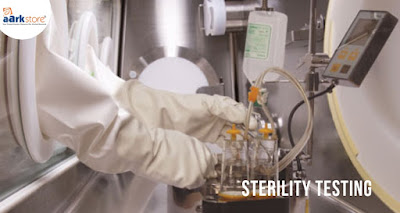Sterility testing is carried out to confirm that products are free from microorganisms. It is imperative for medical devices, vaccines, pharmaceuticals, preparations, tissue materials, and other materials to be tested for sterility. Sterilization can be carried out in various ways including heat, chemicals, irradiation, high pressure, and filtration. Sterilization is similar to disinfection, sanitization, and pasteurization.
The global sterility testing market was valued at USD 540.1 million in 2017 and is expected to register a CAGR of 11.10% during the forecast period from 2018 to 2023.
In the sterilization process, microorganisms are either killed or are made inactive while biological agents are also eliminated. Most medical and surgical devices used in the pharmaceuticals industry are made of materials that are heat stable and therefore undergo heat, primarily steam, sterilization. However, increasingly, medical devices and instruments are being made of materials that require low-temperature sterilization.
The prevalence of chronic and highly communicable diseases such as AIDS is a major driver for market growth. The other factors responsible for market growth are innovation in drugs and government initiatives.
However, strict regulatory bodies and stringent regulatory policies are expected to restrain market growth during the forecast period.
The prevalence of chronic and highly communicable diseases such as AIDS is a major driver for market growth. The other factors responsible for market growth are innovation in drugs and government initiatives.
However, strict regulatory bodies and stringent regulatory policies are expected to restrain market growth during the forecast period.
The global sterility testing market has been segmented by product type, test type, and end user.
The global sterility testing market has been divided, by product type, into instrument, consumable, and services.
The global sterility testing market has been divided, by product type, into instrument, consumable, and services.
Based on the test type, the global sterility testing market has been categorized as membrane filtration, direct transfer sterility testing, and product flush sterility testing.
On the basis of the end user, the market has been classified as hospitals and clinics, pharmaceuticals industry, and academics and research laboratories
Key Players
Some of the Key Players in the global sterility testing market are Merck KGaA (Germany), Pacific BioLabs Inc (US), Belimed Deutschland GmbH (Germany), Boston Scientific Corporation (US), Charles River Laboratories Inc. (US), Sartorius AG (Germany), BioMérieux SA (France), Baxter BioPharma Solutions (US), Astell Scientific (UK), SGS SA (Switzerland), Thermo Fisher Scientific Inc. (US), Becton Dickinson and Company (US), WuXi AppTec (China), Bioquell UK Ltd (UK), and Azbil Telstar SL (Spain).
Objectives of the Study
Objectives of the Study
• To provide a detailed analysis of the market structure along with a forecast of various segments and sub-segments of the global sterility testing market
• To provide insights into factors influencing and affecting market growth
• To provide historical and forecast revenue of market segments and sub-segments with respect to countries
• To provide strategic profiling of Key Players in the market and comprehensively analyzing their market share, core competencies, and drawing a competitive landscape for the market
• To provide economic factors that influence the global sterility testing market
• To provide a detailed analysis of the value chain and supply chain of the global sterility testing market
• To provide insights into factors influencing and affecting market growth
• To provide historical and forecast revenue of market segments and sub-segments with respect to countries
• To provide strategic profiling of Key Players in the market and comprehensively analyzing their market share, core competencies, and drawing a competitive landscape for the market
• To provide economic factors that influence the global sterility testing market
• To provide a detailed analysis of the value chain and supply chain of the global sterility testing market
Key Findings
• The global sterility testing market is expected to reach USD 942.5 million by 2023 at a CAGR of 11.10% from 2018 to 2023.
• On the basis of the test type, the membrane filtration segment accounted for the largest market share of 9.8% in 2017 and was valued at USD 350.7 million by 2023.
• The market in the Americas is expected to account for the largest share of the global sterility testing market and is projected to reach USD 520 million by 2023.
• The market in Asia-Pacific is projected to be the fastest-growing at a CAGR of 7.5% from 2018 to 2023.
Regional Analysis
• On the basis of the test type, the membrane filtration segment accounted for the largest market share of 9.8% in 2017 and was valued at USD 350.7 million by 2023.
• The market in the Americas is expected to account for the largest share of the global sterility testing market and is projected to reach USD 520 million by 2023.
• The market in Asia-Pacific is projected to be the fastest-growing at a CAGR of 7.5% from 2018 to 2023.
Regional Analysis
• Americas: North America, US, Canada, Latin America
• Europe: Germany, France, UK, Italy, Spain, Rest of Europe
• Asia-Pacific: Japan, China, India, Australia, South Korea, Rest of Asia-Pacific
• Middle East & Africa: Middle East, Africa
Related Reports: Healthcare Market Reports
Contact Details:
Aarkstore Enterprise
+91 7710006788 | contact@aarkstore.com | aarkstore.com
+91 7710006788 | contact@aarkstore.com | aarkstore.com

No comments:
Post a Comment